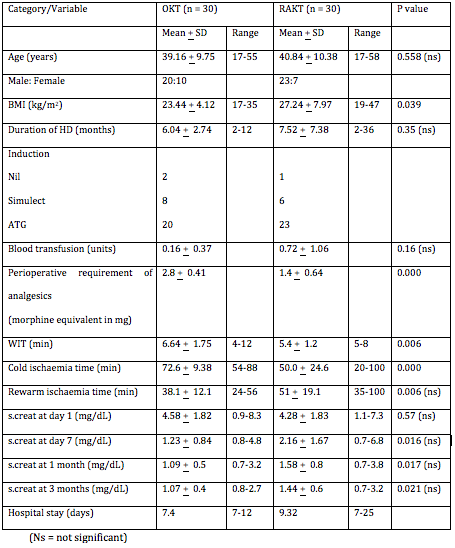Prospective Comparison Between Open and Robot Assisted Kidney Transplant: Our Initial Results
Durgaprasad B1, Ruchir Maheshwari1, Samit Chaturvedi1, Anil Gulia1, Anant Kumar1.
1Urology, Uro-oncology, Robotics and Renal Transplantation, Max Super Specialty Hospital, New Delhi, India
Introduction:Herein, we compare our first 30 consecutive robot assisted kidney transplant (RAKT) with 30 open kidney transplants (OKT) done during the same period.
Materials and methods: All eligible patients were explained about both procedures. Patients were divided into the two groups based on their preference. Right sided grafts and grafts with more than two arteries were excluded. After bench preparation, graft was placed in gauze jacket and placed inside peritoneal cavity using Gel-port or Pfannenstiel incision. Da Vinci surgical system was docked; graft vein and artery were consecutively anastomosed with external iliac vein and artery using end-to-side fashion with Gor-tex® 6-0 suture. Modified Lich-Gregoir ureteroneocystostomy was done. Data was prospectively maintained and analyzed. The comparison was done using Levens’s test for equality of variances and student’s t-test for equality of means.
Results: All patients were live related, either first degree or second-degree relatives. The two groups were comparable in terms of age, sex, duration on hemodialysis (HD) and warm ischemia time (WIT). Recipients in RAKT group were having higher body mass index (BMI). Re-warm ischemia time was longer and fall of creatinine was slower in RAKT as compared OKT, but were not statistically significant. There was statistically significant less requirement of perioperative analgesic dose in RAKT group.
All patients were live related, either first degree or second-degree relatives. The two groups were comparable in terms of age, sex, duration on hemodialysis (HD) and warm ischemia time (WIT). Recipients in RAKT group were having higher body mass index (BMI). Re-warm ischemia time was longer and fall of creatinine was slower in RAKT as compared OKT, but were not statistically significant. There was statistically significant less requirement of perioperative analgesic dose in RAKT group.
One patient in RAKT expired on 25th day due to massive brain haemorrhage. She was a case of juvenile diabetes with diabetic nephropathy and was on HD for 36 months prior to presenting for transplant. Two patients with morbid obesity (BMI – 42 and 47) developed hospital acquired respiratory infection and required ventilator support and colistin. Both recovered completely and their creatinine at 1-year follow up is 1.6 and 2.2 mg/dL respectively. Rest all patients did very well
Conclusions: This is our initial experience of RAKT, which is comparable to our vast experience in OKT. After 10 cases, our anastomosis time and re-warm ischemia time has steadily improved and is presently in well-selected cases, the results are similar. RAKT a very good modality especially in morbidly obese patients, where wound related complications are minimum.
